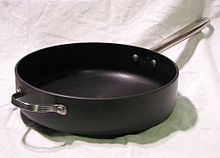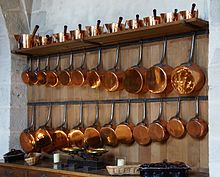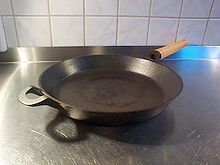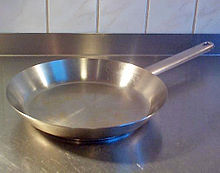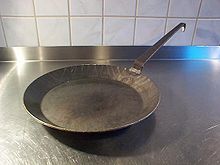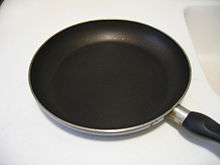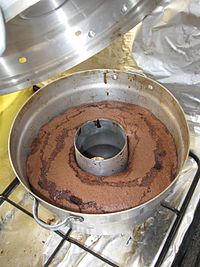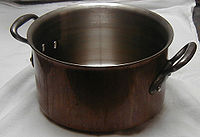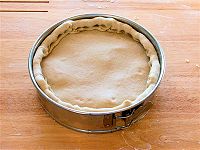- Cookware and bakeware
-
Cookware and bakeware are types of food preparation containers commonly found in the kitchen. Cookware comprises cooking vessels, such as saucepans and frying pans, intended for use on a stove or range cooktop. Bakeware comprises cooking vessels intended for use inside an oven. Some utensils are both cookware and bakeware.
Contents
History
The history of cooking vessels before the development of pottery is minimal due to the limited archaeological evidence. It has been possible to extrapolate likely developments based on methods used by latter peoples. Among the first of the techniques believed to be used by stone age civilizations were improvements to basic roasting. In addition to exposing food to direct heat from either an open fire or hot embers it is possible to cover the food with clay or large leaves before roasting to preserve moisture in the cooked result. Examples of similar techniques are still in use in many modern cuisines.[1]
Of greater difficulty was finding a method to boil water. For people without access to natural heated water sources, such as hot springs, heated stones could be placed in a water-filled vessel to raise its temperature (for example, a leaf-lined pit or the stomach from animals killed by hunters).[2] In many locations the shells of turtles or large mollusks provided a source for waterproof cooking vessels. Bamboo tubes sealed at the end with clay provided a usable container in Asia, while the inhabitants of the Tehuacan Valley began carving large stone bowls that were permanently set into a hearth as early as 7000 BC.
According to Frank Hamilton Cushing, native American cooking baskets used by the Zuni (Zuñi) developed from mesh casings woven to stabilize gourd water vessels. He reported witnessing cooking basket use by Havasupai in 1881. Roasting baskets covered with clay would be filled with wood coals and the product to be roasted. When the thus hardened clay separated from the basket, it would become a usable clay roasting pan in itself. This indicates a steady progression from use of woven gourd casings to waterproof cooking baskets to pottery. Other than in many other cultures, native Americans used and still use the heat source inside the cookware. Cooking baskets are filled with hot stones and roasting pans with wood coals.[3] Native Americans, both in the East and in the West, would form a basket from large leaves to boil water, according to historian and novelist Louis L'Amour. As long as the flames did not reach above the level of water in the basket, the leaves would not burn through.[citation needed]
The development of pottery allowed for the creation of fireproof cooking vessels in a variety of shapes and sizes. Coating the earthenware with some type of plant gum, and later ceramic glazes, converted the porous container into a waterproof vessel. The earthenware cookware could then be suspended over a fire through use of a tripod or other apparatus, or even be placed directly into a low fire or coal bed as in the case of the pipkin. Ceramics (including stoneware and glass) conduct poorly, however, so ceramic pots must cook over relatively low heats and over long periods of time (most modern ceramic pots will crack if used on the stovetop, and are only intended for the oven). Even after metal pots have come into widespread use, earthenware pots are still preferred among the less well-off, globally, due to their low production cost.[citation needed]
The development of bronze and iron metalworking skills allowed for cookware made from metal to be manufactured, although adoption of the new cookware was slow due to the much higher cost. After the development of metal cookware there was little new development in cookware, with the standard Medieval kitchen utilizing a cauldron and a shallow earthenware pan for most cooking tasks, with a spit employed for roasting.[4][5]
By the 17th century, it was common for a Western kitchen to contain a number of skillets, baking pans, a kettle and several pots, along with a variety of pot hooks and trivets. In the American colonies, these items would commonly be produced by a local blacksmith from iron while brass or copper vessels were common in Europe and Asia. Improvements in metallurgy during the 19th and 20th centuries allowed for pots and pans from metals such as steel, stainless steel and aluminum to be economically produced.[5]
Cookware materials
Metal
Metal pots are made from a narrow range of metals because pots and pans need to conduct heat well, but also need to be chemically unreactive so that they do not alter the flavor of the food. Most materials that are conductive enough to heat evenly are too reactive to use in food preparation. In some cases (copper pots, for example), a pot may be made out of a more reactive metal, and then tinned or clad with another.
Aluminium
Aluminium is a lightweight metal with very good thermal conductivity. It is resistant to many forms of corrosion. Aluminum is commonly available in sheet, cast, or anodized forms,[6] and may be physically combined with other metals (see below).
Sheet aluminium is spun or stamped into form. Due to the softness of the metal it may be alloyed with magnesium, copper, or bronze to increase its strength. Sheet aluminum is commonly used for baking sheets, pie plates, and cake or muffin pans. Deep or shallow pots may be formed from sheet aluminium.
Cast aluminum can produce a thicker product than sheet aluminum, and is appropriate for irregular shapes and thicknesses. Due to the microscopic pores caused by the casting process, cast aluminum has a lower thermal conductivity than sheet aluminium, and is more expensive. Accordingly, cast aluminium cookware has become less common. It is used for Dutch ovens, heavyweight baking pans such as bundt pans, and wares such as ladles or handles where low thermal conductivity is desired.
Anodized aluminium has had the naturally occurring layer of aluminum oxide thickened by an electrolytic process to create a surface that is hard and non-reactive. It is used for sauté pans, stockpots, roasters, and Dutch ovens.[6]
Uncoated and un-anodized aluminum can react with acidic foods to change the taste of the food. Sauces containing egg yolks, or vegetables such as asparagus or artichokes may cause oxidation of non-anodized aluminum.
Aluminum exposure has been suggested as a risk factor for neurodegenerative diseases such as Alzheimer's disease. The Rondeau, Commenges et al. article cited below states "These findings support the hypothesis that aluminum in drinking water is a risk factor for AD." (Alzheimer's disease)".[7][8][9][10] The Alzheimer's Association states that "studies have failed to confirm any role for aluminum in causing Alzheimer's. [Today] few [experts] believe that everyday sources of aluminum pose any threat."[11] According to Dr. Morton Walker on page 98 of his 1994 book Toxic Metal Syndrome: How Metal Poisonings Can Affect Your Brain, the Alzhhimer's Association has accepted funding from major players in the aluminium industry.
Copper
In classical Western cooking, pots are formed with thick copper sheets with a thin inner layer of tin. The copper provides the best thermal conductivity of common metals and therefore results in even heating. Copper is reactive with acidic foods, discovered with the discovery of tomatoes in the new world and subsequent introduction to old world copper pots. The tin lining prevents the copper from reacting with acidic foods. The products resulting from the reaction causes copper toxicity. The lead-free and cadmium-free tin lining is susceptible to tin pest. In some cases unlined copper is desirable, for instance in the preparation of meringues and foams. Copper pots are expensive and require retinning, and when made with thick copper plates are heavy. With modern metallurgical techniques, such as cladding, copper is incorporated into the constructions of cookware, often as an enclosed heat spreading disk (see below).
Cast Iron
Main article: Cast iron cookwareCast iron cookware is slow to heat, but once at temperature provides even heating. Cast iron can also withstand very high temperatures, making cast iron pans ideal for searing. Being a reactive material, cast iron can have chemical reactions with high acid foods such as wine or tomatoes. In addition, some foods (such as spinach) cooked on bare cast iron will turn black.
Cast iron is a porous material that rusts easily. As a result, it typically requires seasoning before use. Seasoning creates a thin layer of oxidized fat over the iron that coats and protects the surface, and prevents sticking.
Enameled cast iron cookware was developed by Le Creuset. In 1934, Le Creuset also solved the problem of excessive evaporation and scorching when using the cast iron Dutch ovens during cooking, by creating the enameled cast iron doufeu.
Stainless Steel
Stainless steel is an iron alloy containing a minimum of 11.5% chromium. Blends containing 18% chromium with either 8% nickel,called 18/8, or with 10% nickel, called 18/10, are commonly used for kitchen equipment. Stainless steel's virtues are resistance to corrosion, non-reactivity with either alkaline or acidic foods, and resistance to scratching and denting. Stainless steel's drawbacks for cooking use is that it is a relatively poor heat conductor and contains chromium; a toxic metal considered unsafe when ingested as metal particles. Since the material does not adequately spread the heat itself, stainless steel cookware is generally made with a disk of copper or aluminum in or on the base to conduct the heat across the base.
Carbon Steel
Carbon steel cookware can be rolled or hammered into very thin sheets of material, while still maintaining high strength and heat resistance. This allows for rapid and high heating. Carbon steel does not conduct heat as well as other materials, but this may be an advantage for woks and paella pans, where one portion of the pan is intentionally kept at a different temperature than the rest. Like cast iron, carbon steel must be seasoned before use. Rub a fat (lard is recommended) on the cooking surface only and heat the cookware over the stovetop. The process can be repeated if needed. Over time, the cooking surface will become dark and nonstick. Carbon steel will very easily get rusted if not seasoned and it should be stored seasoned to avoid rust during storage. However, such a rust is not a thread to human's health, because it is from rust from iron, but will shorten quickly the life of the cookware. Carbon steel is often used for woks and crêpe pans.
Non-stick
(Needs content)
Coated and composite cookware
Enameled cast iron
Enameled cast iron cooking vessels are made of cast iron covered with a porcelain surface. This creates a piece that has the heat distribution and retention properties of cast iron combined with a non-reactive, low-stick surface.
Enamel over steel
The enamel over steel technique creates a piece that has the heat distribution of carbon steel and a non-reactive, low-stick surface. Such pots are much lighter than most other pots of similar size, are cheaper to make than stainless steel pots, and do not have the rust and reactivity issues of cast iron or carbon steel.[citation needed] Enamel over steel is ideal for large stockpots and for other large pans used mostly for water-based cooking. Because of its light weight and easy cleanup, enamel over steel is also popular for cookware used while camping.
Clad aluminum or copper
Cladding is a technique for fabricating pans with a layer of heat conducting material, such as copper or aluminum, covered by a non-reactive material, such as stainless steel. Rather than just a heat-distributing disk on the base, the copper or aluminum extends over the entire pan.[citation needed]
Aluminum pans are typically clad on both their inside and the outside surfaces, providing both a stainless cooking surface and a stainless surface to contact the cooktop. Copper is typically clad on its interior surface only, leaving the more attractive copper exposed on the outside of the pan.
Some high-end cookware uses a dual-clad process, with a thin stainless layer on the cooking surface, a thick core of aluminum to provide structure and heat diffusion, and a thin layer of copper on the outside of the pot that provides additional diffusion and the "look" of a copper pot. This provides much of the functionality of tinned-copper pots for a fraction of the price.[12]
Non-metallic cookware
Non-metallic cookware can be used in both conventional and microwave ovens. Non-metallic cookware typically can't be used on the stovetop, but some kinds of ceramic cookware, for example Corningware and Pyroflam, are an exception.
- Ceramics
- Glazed ceramics, such as porcelain, provide a nonstick cooking surface. Some unglazed ceramics, such as terra cotta, have a porous surface that can hold water or other liquids during the cooking process, adding moisture in the form of steam to the food. Historically some glazes used on ceramic articles have contained high levels of lead, which can possess health risks.
- Glass
- Borosilicate glass, such as Pyrex, is safe at oven temperatures. The clear glass also allows for the food to be seen during the cooking process. However, it can't be used on the stovetop as it cannot cope with stove's temperatures.
- Glass-ceramic
- Glass ceramic is used to make products such as Corningware in the USA and Pyroflam in Europe, which have many of the best properties of both glass and ceramic cookware. While Pyrex can shatter if taken between extremes of temperature too rapidly, glass-ceramics can be taken directly from deep freeze to the stove top. Their near-zero coefficient of thermal expansion makes them almost entirely immune to thermal shock.
- Silicone
- Silicone bakeware is light, flexible, and able to withstand sustained temperatures of 675 °F (360 °C).[13][14] It melts around 930°F (500°C), depending upon the fillers used. Its flexibility is advantageous in removing baked goods from the pan. This rubbery material is not to be confused with the silicone resin used to make hard, shatterproof children's dishware, which is not suitable for baking.
Types of cookware and bakeware
The size and shape of a cooking vessel is typically determined by how it will be used. Cooking vessels are typically referred to as "pots" and "pans," but there is great variation in their actual shapes. Most cooking vessels are roughly cylindrical.
Cookware
- Braising pans and roasting pans (also known as braisers and roasters) are large, wide and shallow, to provide space to cook a roast (chicken, beef, or pork). They typically have two loop or tab handles, and may have a cover. Roasters are usually made of heavy gauge metal so that they may be used safely on a cooktop following roasting in an oven. Unlike most other cooking vessels, roasters are usually oblong or oval. There is no sharp boundary between braisers and roasters - the same pan, with or without a cover, can be used for both functions. In Europe, a clay roaster (Swedish: Lergryta, German: Römertopf, Slovene: Rimski lonec) is still popular because it allows roasting without adding grease or liquids. This helps preserve flavor and nutrients. Having to soak the pot in water for 15 minutes before use is a notable drawback.
- Casserole pans (for making casseroles) resemble roasters and Dutch ovens, and many recipes can be used interchangeably between them. Depending on their material, casseroles can be used in the oven or on the stovetop. Casseroles are commonly made of glazed ceramics or pyrex.
- Dutch ovens are heavy, relatively deep pots with a heavy lid, designed to re-create oven conditions on the stovetop (or campfire). They can be used for stews, braised meats, soups, and a large variety of other dishes that benefit from low heat, slow cooking. Dutch ovens are typically made from cast iron, and are measured by volume.
-
- A Wonder Pot is an Israeli invention that acts as a dutch oven but is made of aluminum. It consists of three parts: an aluminum pot shaped like a Bundt pan, a hooded cover perforated with venting holes, and a thick, round, metal disc with a center hole that is placed between the Wonder Pot and the flame to disperse heat.
- Frying pans, frypans, or skillets provide a large flat heating surface and shallow sides, and are best for pan frying. Frypans with a gentle, rolling slope are sometimes called omelette pans. Grill pans are frypans that are ribbed, to let fat drain away from the food being cooked. Frypans and grill pans are generally measured by diameter (20–30 cm).
-
- Spiders are skillets with three thin legs to keep them above an open fire. Ordinary flat-bottomed skillets are also sometimes called spiders, though the term has fallen out of general use.[15]
- Griddles are flat plates of metal used for frying, grilling, and making pan breads (such as pancakes, injera, tortillas, chapatis, and crepes). Traditional iron griddles are circular, with a semicircular hoop fixed to opposite edges of the plate and rising above it to form a central handle. Rectangular griddles that cover two stove burners are now also common, as are griddles that have a ribbed area that can be used like a grill pan. Some have multiple square metal grooves enabling the contents to have a defined pattern, similar to a waffle maker. Like frypans, round griddles are generally measured by diameter (20–30 cm).
-
- Both griddles and frypans can be found in electric versions. These may be permanently attached to a heat source, similar to a hot plate.
- Saucepans (or just "pots") are vessels with vertical sides about the same height as their diameter, used for simmering or boiling. Saucepans generally have one long handle. Larger pots of the same shape generally have two handles close to the sides of the pot (so they can be lifted with both hands), and are called sauce-pots or soup pots (3–12 liters). Saucepans and saucepots are measured by volume (usually 1–8 L). While saucepots often resemble Dutch ovens in shape, they do not have the same heat capacity characteristics. Very small saucepans used for heating milk are referred to as milk pans, such saucepans usually have a lip for pouring the heated milk.
-
- Ironically, the saucepan is not the ideal vessel to use for making sauces. It is more efficient to use saucepans with sloping sides, called Windsor pans, or saucepans with rounded sides, called sauciers. These provide quicker evaporation than straight sided pans, and make it easier to stir a sauce while reducing.
- Sauté pans, used for sauteing, have a large surface area and low sides to permit steam to escape and allow the cook to toss the food. The word "sauté" comes from the French verb "sauter", meaning to jump. Saute pans often have straight vertical sides, but may also have flared or rounded sides.
- Stockpots are large pots with sides at least as tall as their diameter. This allows stock to simmer for extended periods of time without reducing too much. Stockpots are typically measured in volume (6-36 L). Stock pots come in a large variety of sizes to meet any need from cooking for a family to preparing food for a banquet. A specific type of stockpot exists for lobsters, and an all-metal stockpot usually called a caldero is used in Hispanic cultures to make rice.
- Woks are wide, roughly bowl-shaped vessels with one or two handles at or near the rim. This shape allows a small pool of cooking oil in the center of the wok to be heated to a high heat using relatively little fuel, while the outer areas of the wok are used to keep food warm after it has been fried in the oil. In the Western world, woks are typically used only for stir-frying, but they can actually be used for anything from steaming to deep frying.
Bakeware
Bakeware is designed for use in the oven (for baking), and encompasses a variety of different styles of baking pans as cake pans, pie pans, and loaf pans.
- Cake pans include square pans, round pans, and speciality pans such as angel food cake pans and springform pans often used for baking cheesecake.
- Sheet pans, cookie sheets, and jelly-roll pans are bakeware with large flat bottoms.
- Pie pans are flat-bottomed flare-sided pans specifically designed for baking pies.
List of cookware and bakeware
- Baking pan
- Beanpot
- Chip pan
- Cookie sheet
- Cooking pot
- Crepe pan
- Double boiler
- Doufeu
- Dutch oven
- Frying pan (also called Skillet)
- Griddle (also called Tawa in Hindi)
- Karahi
- Kettle
- Pressure cooker
- Ramekin
- Roasting pan
- Roasting rack
- Saucepan (described in current article)
- Saucier (described in current article)
- Sauté pan
- Splayed Sauté pan
- Soufflé dish
- Springform pan
- Stockpot
- Tajine
- Tube pan [types include angel food cake pan and Bundt cake (Gugelhupf) pan]
- Wok
- Wonder Pot
See also
- Bakeware
- Cauldron
- Stoneware
- Gastronorm sizes (standard sizes of container)
- Kitchenware
- Kitchenware Brands
- List of food preparation utensils
- Pottery
- Pressure cooking
- Kappabashi-dori
- Food storage
- Food preparation
Notes
- ^ Tannahill pg 13
- ^ Tannahill pg 14-16
- ^ Online Reader - Project Gutenberg
- ^ Tannahill pg 16, 96
- ^ a b Beard pg 174-175
- ^ a b Williams1986, pp. 8–9
- ^ "Aluminium and Alzheimer's disease". Facts about dementia. Alzheimer's Society. http://www.alzheimers.org.uk/Facts_about_dementia/Risk_factors/info_aluminium.htm. Retrieved October 14, 2005.
- ^ Shcherbatykh I, Carpenter DO (May 2007). "The role of metals in the etiology of Alzheimer's disease". J. Alzheimers Dis. 11 (2): 191–205. PMID 17522444.
- ^ Rondeau V, Commenges D, Jacqmin-Gadda H, Dartigues JF (July 2000). "Relation between aluminum concentrations in drinking water and Alzheimer's disease: an 8-year follow-up study". Am. J. Epidemiol. 152 (1): 59–66. doi:10.1093/aje/152.1.59. PMC 2215380. PMID 10901330. http://www.pubmedcentral.nih.gov/articlerender.fcgi?tool=pmcentrez&artid=2215380.
- ^ Rondeau, V.; Jacqmin-Gadda, H.; Commenges, D.; Helmer, C.; Dartigues, F. (Feb 2009). "Aluminum and silica in drinking water and the risk of Alzheimer's disease or cognitive decline: findings from 15-year follow-up of the PAQUID cohort". American journal of epidemiology 169 (4): 489–496. doi:10.1093/aje/kwn348. ISSN 0002-9262. PMC 2809081. PMID 19064650. http://www.pubmedcentral.nih.gov/articlerender.fcgi?tool=pmcentrez&artid=2809081.
- ^ "Myth 4: Drinking out of aluminum cans or cooking in aluminum pots and pans can lead to Alzheimer’s disease". Alzheimer Myths. Alzheimer's Association. http://www.alz.org/alzheimers_disease_myths_about_alzheimers.asp. Retrieved June 19, 2010.
- ^ Williams1986, pp. 9–10
- ^ Kitchenkapers.com
- ^ SiliconeZone Bakeware - Kitchenware, Automatic Coffee Machines & More
- ^ Journalofantiques.com
References
- Beard, James (1975). The Cooks' Catalogue. et al.. Harper & Row. ISBN 0-06-011563-7.
- Bridge, Fred; Tibbetts, Jean F. (1991). The Well-Tooled Kitchen. William Morrow and Company. ISBN 0-688-08135-5.
- Houlihan, Jane; Thayer, Kris; Klien, Jennifer (May 2003). "Canaries in the Kitchen: Teflon Toxicosis". Environmental Working Group. http://www.ewg.org/reports/toxicteflon. Retrieved 21 April 2010.
- Reay Tannahill (1988). Food in History. Crown Publishers. ISBN 0-517-57186-2.
- Williams, Chuck (1986). The Williams-Sonoma Cookbook and Guide to Kitchenware. Random House. ISBN 0-394-54411-0.
Categories:
Wikimedia Foundation. 2010.


